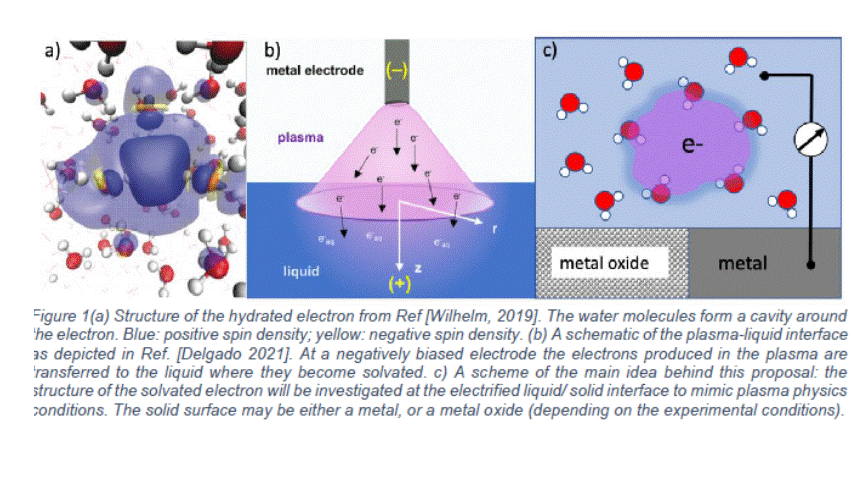B14: The solvated Electron at the electrified solid/liquid interface: structure and dynamics from ab initio molecular dynamics simulations
Principal Investigators: M. Sulpizi
Team

Sulpizi, Marialore (Principal Investigator) |

Gomes, Anna (PhD) |
Description

Aim of this project is the structural and dynamical characterization of the solvated electron in the presence of applied electric fields, in different environments, including liquid interfaces in contact with a conducting or insulating solid. The solvated electron is a specie which is central to field of plasma/liquid and plasma/solid/liquid interfaces as the primary reducing agent which is produced at plasma electrodes in contact with a liquid. Although the solvated electron has been subject of intensive experimental and theoretical investigation under equilibrium conditions, its properties in the presence of electric fields, are still quite unexplored. Here we plan to use atomistic molecular dynamics simulations including the electronic structure to understand the impact of electric fields on the structure and dynamics of the solvated electron. Ab initio molecular dynamics simulations, where the forces are calculated using hybrid functionals, have been shown to be not only quite accurate in reproducing electronic properties of heterogenous systems, but to be within reach for systems on the nanometer scale which is the relevant scale of the fundamental processes occurring at the metal/water and the oxide/water interfaces. Our project is expected to shed light on properties of solvated electron under non equilibrium conditions, in a variety of different environments which are of relevance to the SFB1316. Knowledge of structure, dynamics, reactivity of the solvated electrons is necessary to improve the performance of material and chemical synthesis in the plasma electrolysis. Collaborations is planned with the projects of the B area, with the particular aim (i) to compare computed and calculated optical and vibrational spectra to validate models and provide a molecular interpretation of the experiments; (ii) to transfer knowledge across different resolution scales: the data obtained from our simulations will help to develop less computationally demanding models to be applied on larger scales and will be able to provide a more realistic description of the electric double layer at the solid/liquid interface which can be used to improve the models used in the simulations of plasma-chemical kinetics.
Publications
Thesis
- Anna K. M. Silva Gomes, PhD thesis - ongoing
The solvated Electron at the electrified solid/liquid interface: structure and dynamics from ab initio molecular dynamics simulations

